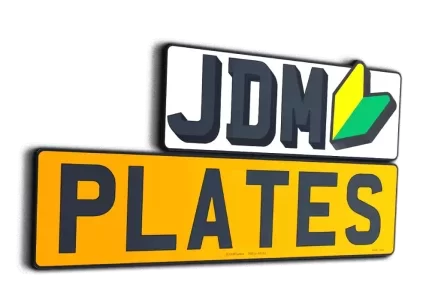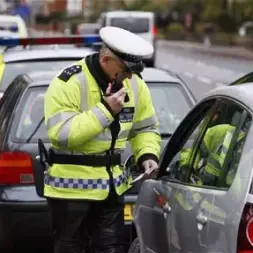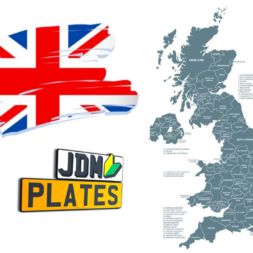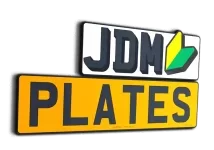Fined because of 3D gel or 4D number plates?
4D number plates, the style under constant scrutiny with law enforcement officers and MOT stations; some say they are legal, whereas others are adamant that they are not! Have you been fined because of 4D number plates in the past? Well, here at JDM Plates, we have a couple of case studies and general information that may tickle your fancy so please feel free to read on as we have had direct experiences with customers being fined, MOT stations suggesting 4D number plates are not MOT compliant or road legal and even police officers thinking they are in the right, when in-fact, they have wrongfully been issuing members of the public £100 fines under Section 59(1) of the Vehicle Excise and Registration Act 1994.
There is a vast range of 4D, and 3D number plate, styles in today’s market, whether they’re 3mm or 5mm thick acrylic lettering; 3mm or 5mm thick acrylic letters with a gel topping; smaller 4D number plates; electric number plates with raised 4D lettering or even shaped number plates such as diamond or hex number plates with 3D gel or 4D characters.
However, all of the above can be and in the majority of the case – will be – road legal and fully compliant although motorists do need to be aware that not all number plates with raised lettering are road legal if the layout of marks have been manipulated or minimum margins or character sizes have been contravened. If this is the case, then yes, a law enforcement officer will likely issue a motorist with a £100 fine under Section 59(1) of the aforementioned statutory act..
Further reasons as to why motorists may be fined because of 4D number plates.
Illegal spacing:
Mis-spaced number plates are, in most cases, eye-catching and appealing. Personalised registration numbers are likely to be purchased because they spell out a name or a word. However, in order to spell out these names and words, the spacing of the registration may need to be manipulated and therefore not road legal.
There should be a smaller gap between each number plate character and a larger gap between the two groups of characters; this is a must and needs to reflect the paperwork the registration number is printed on; generally the V5c logbook, Retention Certificate or Certificate of Entitlement. Confusion does sometimes occur when assigning a registration online via the DVLA portal using a DVLA account as sometimes the larger gaps are not displayed!
The number plate character spacing is also different depending on the type of vehicle the registration plate is to be mounted to and not the registration number itself. We have already covered this in another article when discussing imported number plates on UK vehicles but UK cars need 11mm horizontal gaps between letters and a 33mm horizontal gap between the two groups whereas imported cars and motorcycles need 10mm and 30mm gaps respectively. UK cars also need a 19mm vertical gap between rows whereas motorcycles need a 13mm horizontal gap and imported cars only need a 5mm horizontal gap between rows.

As it can be noticed, the above image shows the legal spacing between the first group and second group of characters whereas the image below does not. If a registration spacing has been manipulated in any way, shape or form, then unfortunately a fine will be valid if ever issued with one.

Number Plate Sizing:
The overall sizing of a number plate can be a contentious area. For instance, MOT guidance notes stipulate that MOT testers can legally pass a small motorcycle number plate even if it is too small to be road legal so long as the aspect ratio is maintained. The gray area with this is that even though the number plate will have passed an MOT, it won’t actually be road legal. We have an article which discusses this in a deeper context which also references DVSA MOT inspection guides and whether 4D number plates are MOT friendly. This may be a good read if yourself, or know someone, has recently been fined because of their 4D number plates.
A number plate can legally be as large as the car physically allows it to be. Legislation with regards to sizing of road legal number plates mainly revolves around the number of characters a registration plate has and the vehicle type the plate is to be fixed to. For instance, number plate characters need to be 50mm wide x 79mm high on UK vehicles whereas imported cars and motorcycles only need to be 44mm wide x 64mm high. When considering this, along with the letter gaps, margins and spacings, it can be quickly concluded that minimum number plate sizes need to be met in order to be compliant and road legal. If a number plate is too small, or the characters, margins or spacings are not big enough; law enforcement officers could issue a £100 fine under the relevant Legislative Acts.
Colour of 4D number plate letters:
Prior to 2021, fluorescent and neon number plates were a bit of a craze. However, post September 2021 the new British Standard was made mandatory which stipulated that all number plates can now only be one shade of colour and one consistent shade of black.
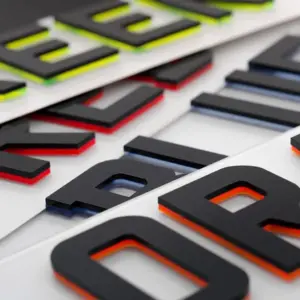
If a motorist has recently been fined because of having neon number plates on their pride and joy, it is unfortunate that the fine is still valid.
Although legislation cannot be retrospectively enforced, MOT stations should have flagged the number plates up as a failure and therefore replaced as necessary. However, some argue that because neon number plates may have been purchased before September 2021 and display the old British Standard kitemark; BSau 145d, then they should still be legal. Unfortunately this is not the case and any 4D neon or 4D fluorescent number plates used on the public highway will be received with a £100 fine.
3D printed number plates and Carbon fibre effect 4D number plates would also receive the same scrutiny as the new Regulations stipulate that number plates need to also be a single shade of black.
Legal Markings & Manufactures Information:
If none of the above conditions have been met, number plate manufacturers will not print their legal markings or the British standard kitemark on the bottom section of a number plate. If no legal markings are displayed, then unfortunately a £100 fine is valid.
We have had customers in the past state that they have been fined for a short 4d number plate and argue that our small number plates are therefore not legal. However, the actual reason as to why the majority of short number plates are issued a fine is because of no legal markings being displayed.
On some occasions, typically with eBay sellers or sellers who do not have a legitimate Registered Number Plate Supplier (RNPS) number, or sellers not within the DVLA’s jurisdiction such as companies based within Jersey or Ireland; manufactures will just print some detail on the bottom of a number plate to make them look authentic and road legal. However, if the above requirements with regards to letter colouring, number plate sizing and spacings are not complied with then a £100 fine will still be issued!
Law enforcement officers think 4D number plates aren’t legal…
Unfortunately, some law enforcement officers issue fines because they simply think 4D number plates aren’t road legal. Well, this is just not the case and 99% of the time, fines are wrongfully being issued! With a quick bit of research, it can be concluded that so long as all of the requirements above have been complied with, 4D number plates are completely road legal. The Gov.uk website even shows this…
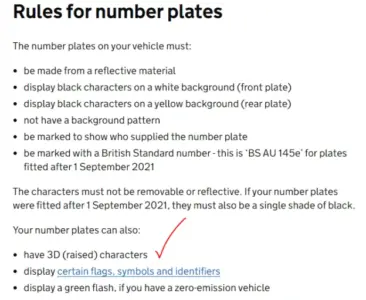
Case Study #1; fined for using 4D import number plates
A previous customer of ours, based in the North of England, ordered a set of 4D 3mm import number plates from us and was initially really pleased with them. However, after a few months, he was stopped and fined by a local police officer due to contravening Section 59(1) of the Vehicle Excise and Registration Act 1994. However, when our customer was initially questioning the officer about when they should be replaced; the officer simply stated, ‘No rush…’ and handed over a juicy £100 fine.
Our customer emailed us and we advised on the situation. As we purchase our 4D number plate materials from a member of the British NumberPlate Manufacturing Association (BNMA), our supplier ensures that all their materials are fully compliant. As we also comply with all legislative requirements, we therefore advised what these were and our customer then put this forward to the relevant officer and their response is as below.
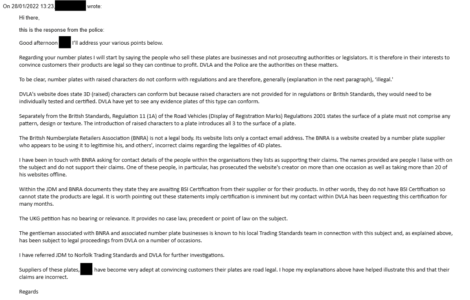
The officer does go on to explain the obvious, however, he then goes on to explain that;
‘3D (raised) characters can conform but because raised characters are not provided for in Regulations or British Standards, they would need to be individually tested and certified.’
Our counter argument would be the fact that pressed metal plates are also not provided for in regulations therefore would they be deemed illegal also?
However, he then goes on to explain that;
‘Regulation 11(1A) of the Road Vehicles (Display of Registration Marks) Regulations 2001 states that the surface of a plate must not comprise any pattern, design or texture. The introduction of raised number plate characters to a plate introduces all 3 to the surface of a plate.’
Well, as of February 2024, Regulation 11 does not state that, which means that relevant legislation has been updated to accommodate 4D number plates, unless these provisions are hidden elsewhere; please see image below:-
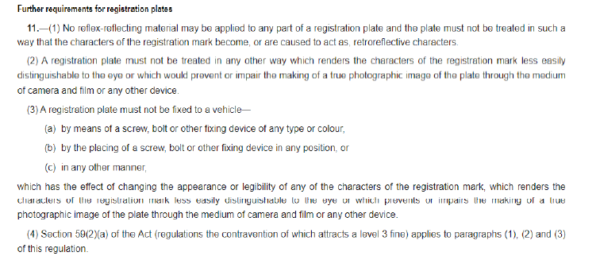
The reporting officer also references the British Number Plate Retailers Association (BNRA) which we never advised on or previously mentioned to our customer as we know they are an organisation made by individual retailers and aren’t a legislative body.
At the time, the reporting officer was adamant that the 4D number plates in question were not legal even after we, JDM Plates and our supplier persistently explained that they were. Our customer then had his number plates taken away and seized and then passed onto DVLA. We were then contacted by Trading Standard but as a good will gesture and due to the inconvenience our customer faced, we remade our him some normal printed number plates so he could still commute to work. However, this was essentially theft as the number plates were perfectly legal.
We then advised our customer to contact his local MP. After explaining everything to his local MP, providing legislative documents and guidance notes proving that 4D number plates are road legal and a £100 fine was wrongfully issued, our customer received a letter explaining that the fine was dropped and no further action would take place.
Eventually, we got the outcome we wanted – whether this was the DVLA informing the enforcing officer they were in fact legal or whether it was the local MP overruling the fine – we don’t quite know. However, this was at the expense of time and effort and sometimes having the right contacts. We don’t want our customers to have complications with the law but at times, needs must, and persistence is key.
Case Study #2; fined for using standard size UK 4D number plates
A local customer of ours was recently fined (October 2023) for having our standard size, 520×111, 4D 3mm number plates fixed to their car. Local law enforcement officers were having a crackdown on vehicles that were not road legal and therefore recorded up to 45 road traffic offenses, within 1 day, in Great Yarmouth alone. The majority of these were uninsured drivers. However, one of our existing customers was fined £100 for ‘illegal number plates’ that didn’t comply with Section 59(1) of the Vehicle Excise and Registration Act 1994…
Section 59(1) states the following:-
‘A person who contravenes or fails to comply with any regulations under this Act (other than any regulations under section 24, 26, 27 or 28) is guilty of an offense.’
Section 26 and 27 are mainly referring to fixing a number plate to a vehicle before the registration number has been successfully transferred from documents such as a certificate of entitlement or retention certificate to the vehicle logbook V5c. However, section 28 is more valid towards the vehicle markings, engine markings and number plate markings all correspond. For example, the vehicle identity numbers (VIN) match.
However, Section 24 is to do with motor dealers. Nevertheless, section 59 talks about failing to comply with ANY Regulations under this Act OTHER THAN… therefore it is vital to ask what the specific section or regulation is being broken because it excludes section 24, 26, 27 and 28 with regards to your vehicle or number plates.
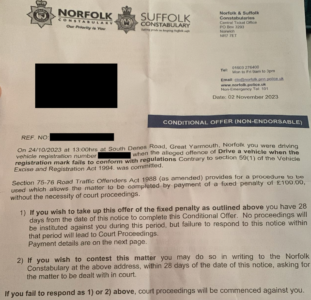
Our customer got in touch with us and once again we forwarded relevant guidance notes, documents and our assurance that 4D number plates are legal and that no fines should have been issued. Our customer then got in contact with the central ticket office (CTO) informing that 4D number plates are road legal:-
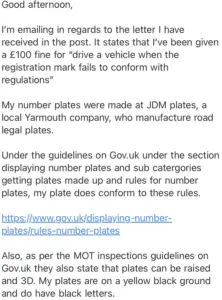
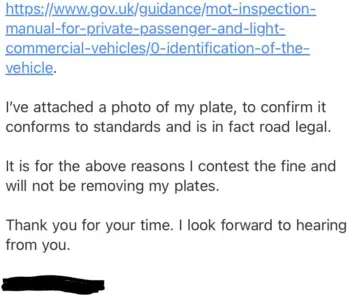
The Central Ticket office eventually did response but unfortunately their basic response is as follows:-
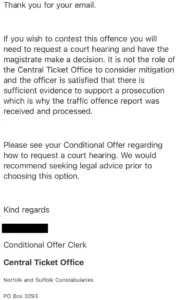
Due to past experiences with regards to case study 1, we asked our customer to also speak to our local MP to see if they could help. Unfortunately he didn’t respond although one of his associates did but without much help. Our customer therefore decided to fight this and contest it in court. After some email correspondence contesting the 4D number plates fine, Norfolk Constabulary contacted the Department of Transport informing them that the fine will be contested and because this was a live case, no answers or comments could be given regarding the fine.
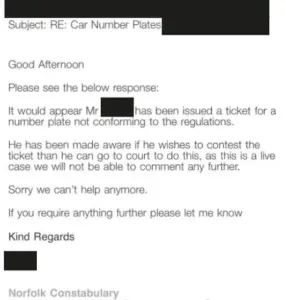
The local policing team also acknowledged that they too tried to contact our local MP and his constituency without any reply. However, they then explain to the Department of Transport that they have, ‘spoken to the department and a letter should be with them next week saying that the case has been discontinued.’
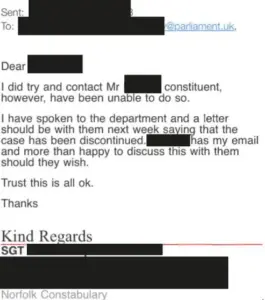
A few days later our customer received a letter informing them that the case had been dropped because ‘an error was made when issuing the traffic offense’.
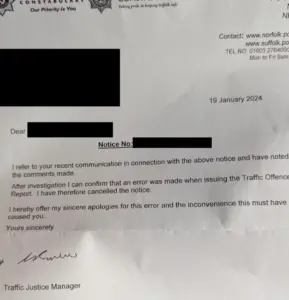
As it can be seen, mistakes happen and eventually, after three months of waiting and contesting, the £100 fine was dropped.
If your 4D number plates comply with all previously mentioned requirements and a fine has been issued; that fine has therefore been wrongfully issued. JDM Plates have witnessed two cases whereby our customers have managed to overturn their fines due to persistence although it does make us wonder how many people have simply paid up.
To summarise; if you have received a fine because of your 4D number plates and you wish to contest it, you need to:-
- Ask why it is illegal; enforcement officers mentioning section 59(1) of the Vehicle Excise and Registration Act 1994 isn’t good enough as that excludes the referenced sections.
- Ensure your 4D plates have the correct spacing, margins, legal information and plain black colouring.
- Seek your local MP and their constituency as they should be willing to help.
- Contact the DVLA directly.
- Reference documentation and links within this article as it provides correct information as of February 2024.
